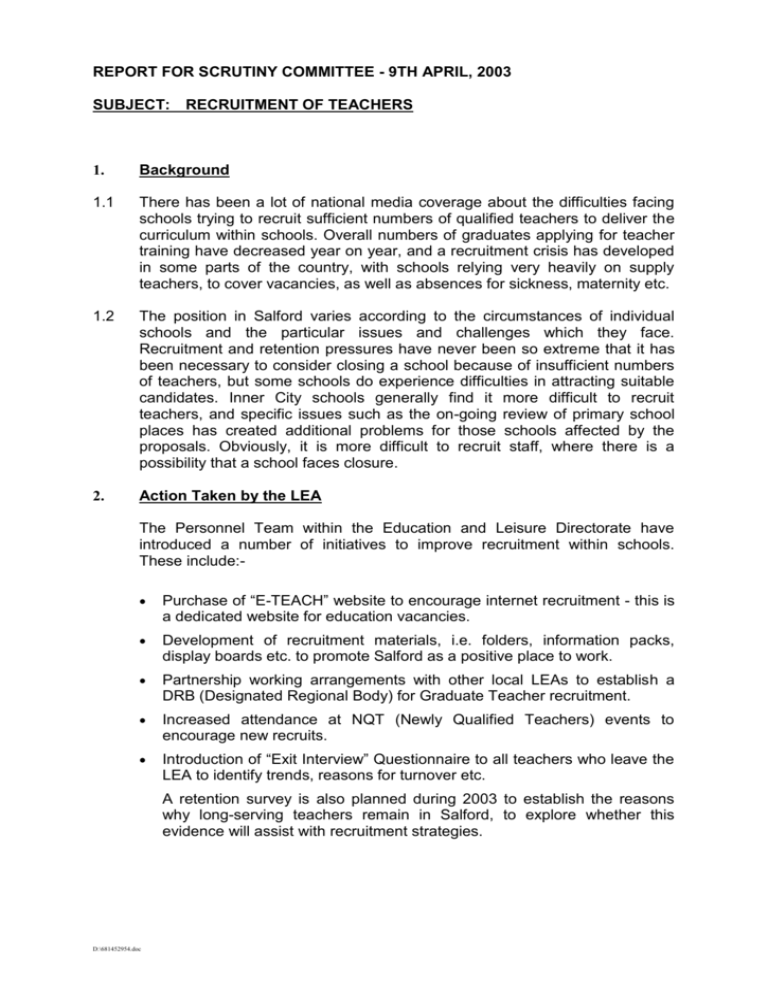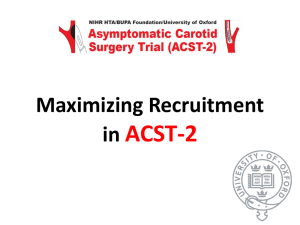report for scrutiny committee - 9th april, 2003
advertisement

REPORT FOR SCRUTINY COMMITTEE - 9TH APRIL, 2003 SUBJECT: RECRUITMENT OF TEACHERS 1. Background 1.1 There has been a lot of national media coverage about the difficulties facing schools trying to recruit sufficient numbers of qualified teachers to deliver the curriculum within schools. Overall numbers of graduates applying for teacher training have decreased year on year, and a recruitment crisis has developed in some parts of the country, with schools relying very heavily on supply teachers, to cover vacancies, as well as absences for sickness, maternity etc. 1.2 The position in Salford varies according to the circumstances of individual schools and the particular issues and challenges which they face. Recruitment and retention pressures have never been so extreme that it has been necessary to consider closing a school because of insufficient numbers of teachers, but some schools do experience difficulties in attracting suitable candidates. Inner City schools generally find it more difficult to recruit teachers, and specific issues such as the on-going review of primary school places has created additional problems for those schools affected by the proposals. Obviously, it is more difficult to recruit staff, where there is a possibility that a school faces closure. 2. Action Taken by the LEA The Personnel Team within the Education and Leisure Directorate have introduced a number of initiatives to improve recruitment within schools. These include: Purchase of “E-TEACH” website to encourage internet recruitment - this is a dedicated website for education vacancies. Development of recruitment materials, i.e. folders, information packs, display boards etc. to promote Salford as a positive place to work. Partnership working arrangements with other local LEAs to establish a DRB (Designated Regional Body) for Graduate Teacher recruitment. Increased attendance at NQT (Newly Qualified Teachers) events to encourage new recruits. Introduction of “Exit Interview” Questionnaire to all teachers who leave the LEA to identify trends, reasons for turnover etc. A retention survey is also planned during 2003 to establish the reasons why long-serving teachers remain in Salford, to explore whether this evidence will assist with recruitment strategies. D:\681452954.doc -2- 3. Vacancies The number of vacancies across schools as at January 2003 is as follows:High Schools Primary Schools Special Schools - 15 5 4 (Total number of Teachers = 701) (Total number of Teachers = 1014) (Total number of Teachers = 87) Further information will be presented at Scrutiny Committee, indicating vacancies and trends across schools over the last year. 4. Supply Teachers The LEA no longer directly operates a supply service for schools, but has agreed partnership arrangements with “HAYS” Agency, which provides supply teachers to Salford schools, and is endorsed by the LEA. During the Autumn Term 2002, a total of 747 days of supply cover was booked with HAYS Agency, for schools. This can be broken down as follows:High Schools Primary Schools Special Schools = = = 173 days 569 days 5 days (15 schools) (44 schools) (4 schools) The main reasons schools use supply cover include: 5. Sickness Maternity Planned absence e.g. teacher absent for interviews, courses e.g. INSET, training days. Other LEA’s - Comparable Information It is difficult to obtain accurate information from other local authorities. The majority of LEA’s now employ Recruitment Strategy Managers (RSM’s) whose full time role is to analyse vacancy information and develop recruitment strategies. Unfortunately, Salford LEA has never received additional funding from the DfES to support such a post. Information available from regional network groups would suggest that Salford is broadly similar to other LEAs. Recruitment difficulties are faced by schools in inner-city areas, and there is generally a shortage of teachers in the areas of Maths, Science and ICT. D:\681452954.doc







